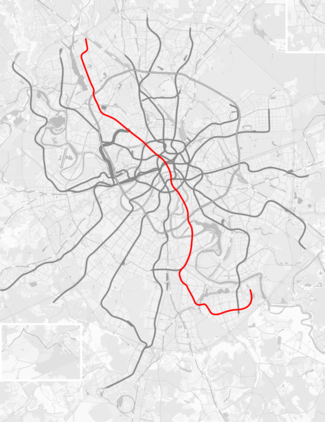Zamoskvoretskaya Line
| 2 Zamoskvoretskaya Line | |
|---|---|
 |
|
| Overview | |
| Type | Rapid transit |
| System | Moscow Metro |
| Locale | Moscow |
| Termini |
Rechnoy Vokzal (northwest) Alma-Atinskaya (southeast) |
| Stations | 22 |
| Daily ridership | 1,230,654 |
| Operation | |
| Opened | September 11, 1938 |
| Owner | Moskovsky Metropoliten |
| Operator(s) | Moskovsky Metropoliten |
| Character | Underground |
| Rolling stock | 81-717/714 |
| Technical | |
| Line length | 39.8 kilometres (24.7 mi) |
| Track gauge | 1,520 mm (4 ft 11 27⁄32 in) |
| Electrification | Third rail |
Zamoskvoretskaya Line (Russian: Замоскворе́цкая ли́ния, IPA: [zəməskvɐˈrʲɛtskəjə ˈlʲinʲɪjə]), formerly Gorkovsko-Zamoskvoretskaya (Го́рьковско-Замоскворе́цкая) (Line 2), is a line of the Moscow Metro. Opened in 1938, chronologically it became the third line. There are 22 stations on the Zamoskvoretskaya line, and it spans 39.8 kilometres (24.7 mi), roughly crossing Moscow in a north-south direction. A normal trip along the entire line takes 55 minutes, with the trains on the line averaging 42 kilometres per hour (26 mph). While most of the line is underground, there are some pockets of surface-level or above-ground track, mainly at the point where the line crosses the Moskva River. The line contains many examples of original Moscow Metro architecture, and contains arguably the most photographed station on the entire network: Mayakovskaya.
The first stage of the line followed Moscow's busiest transport artery the Leningradsky Prospekt or as it moves into the centre the Tverskaya Street (formally Gorkovskaya hence the original name), and connected the northwestern districts of Aeroport and Begovoy along with the Belorussky Rail Terminal with the city centre in 1938.
The second stage, construction of which was uninterrupted during the war, opened in 1943 and followed the Red Square south under the Moskva River into the dense district of Zamoskvorechye (hence the name) and then onto the Paveletsky Rail Terminal and more significantly the Stalin Factory (ZiS) in the Southeast of Moscow.
...
Wikipedia
